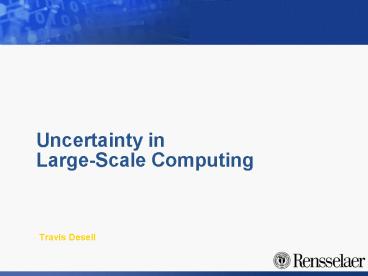Uncertainty in LargeScale Computing - PowerPoint PPT Presentation
1 / 28
Title:
Uncertainty in LargeScale Computing
Description:
Regional computational complexity can change dramatically in both space and time ... Reconfigure if IR threshold. 10/11/09. 13. Natural Region Partitioning ... – PowerPoint PPT presentation
Number of Views:42
Avg rating:3.0/5.0
Title: Uncertainty in LargeScale Computing
1
Uncertainty inLarge-Scale Computing
- Travis Desell
2
Overview
- Motivation
- Uncertainty?
- ARM (Autonomic Runtime Manager)
- Active Harmony
3
Extensible TeraScale Facility (ETF)
RPI
4
iVDGLInternational Virtual Data Grid Laboratory
www.ivdgl.org
5
CERN Worlds Largest Computing Grid
http//goc02.grid-support.ac.uk/googlemaps/lcg.htm
l
www.cern.ch
6
PlanetLab (November 06)
718 Nodes at 315 Sites
7
Map of Rensselaer Grid Clusters
Nanotech
Multiscale
Bioscience Cluster
CS /WCL
Multipurpose Cluster
CS
CCNI Cluster
8
Areas of Uncertainty
- Application
- Non-determinism
- Environment
- Dynamic resource availability
- Unknown target environments
- OS/Hardware effects
- Faults
- Interaction
- Competition
- Distribution
- Unknown performance on different architectures
9
Overview of ARM
- Autonomic Runtime Manager (ARM)
- What is it for?
- What is it?
- Reconfiguration Methodology
- What can it do?
- Graph Partitioning
- Natural Region Partitioning
10
Adaptive Distributed Applications
- Non-deterministic
- Application divided into computational regions
- Regional computational complexity can change
dramatically in both space and time - Example Wildfire Simulation
11
ARM (Autonomic Runtime Manager)
12
When to reconfigure?
- Imbalance Ratio (IR)
- Reconfigure if IR gt threshold
13
Natural Region Partitioning
- Calculate Processor Computational Load (PCL)
- Processor Load Ratio (PLR) is normalization of
PAF - Processor Allocation Factor (PAF) is a ratio of
how fast cells are computed - Application Computational Workload (ACW) is the
total workload of the application
14
Graph Partitioning
- Wildfire simulation domain represented as graph
G(V,E) - Vertices are cells
- Edges connect neighboring cells
- Verticies weighted by computational complexity
- Burning gt Unburned
- Graphs partitioned to create cuts with similar
vertex weight, and inter-cut edges
15
Results
16
Results (Continued)
17
Overview of Active Harmony
- Active Harmony
- What is it?
- Reconfiguration Methodology
- Case Studies
- PETSc
- POP
- GS2
18
Active Harmony
- Previously used for runtime performance tuning in
dynamic environments. - Developers specify tunable parameters which can
modify applications during runtime. - This work focuses on using Active Harmony
off-line as opposed to on-line.
19
Active Harmony Architecture
20
Reconfiguration Methodology
- Representative short runs used to provide
measurements of application performance for
different tuned parameters. - Uses an algorithm based on the Neader-Mead
simplex method. - Parameters are treated as independent dimensions.
- Modified because parameters are non-continuous.
- Iteratively tunes application performance by
repeatedly modifying parameters and converging
and an optimum.
21
Case Study - PETSc
- PETSc Portable Extensible Toolkit for
Scientific Computation - Suite of data structures and routines for
scalable (parallel) solution of scientific
applications based on partial differential
equations - Uses MPI
- Used Active Harmony on two PETSc examples
- SLES linear equation solver, uses matrix
decomposition - 2-D driven cavity problem
22
Results - SLES
- Ran 50x50 matrix decomposition with 4 homogeneous
and 4 heterogeneous processors (see above). - Ran 21,025 x 21,025 matrix decomposition and 32
processors. Resulted in a 18 performance
speedup after tuning. - Also ran 90,601 x 90601 matrix decomposition.
Full search space O(10100). After 120
iterations resulted in a 15-20 performance
improvement.
23
Results 2-DCP
- Uses PETSc SNES non-linear equation solver.
- Tunable parameter is how many grid points
distributed among nodes (default is equal
distribution). - Above shows results from a small problem, 2500
grid points and 4 nodes. - Ran with 40,000 grid points on 32 processors,
speedup was 11.5 over default partitioning.
Search space was O(1036).
24
Case Study - POP
- POP Parallel Ocean Program
- Developed at Los Alamos National Labs.
- Used by the Community Climate System Model (CCSM)
as the ocean component. - Solves three-dimensional primitive equations for
fluid motions on a sphere.
25
Results - POP
- Problem size 3600x2400 grid points divided into
480 blocks (processors). - Default configuration is 180x100 sized block.
- Run on 16-way SMP nodes.
- No single block size is best for all topologies
- Execution time reduced up to 15 by tuning block
size. - Tuning other parameters (20 performance related
with 2-4 possible values) on a 8 node 4 processor
cluster resulted in 12.7 speedup after 12
iterations, and best speedup of 16.7 after 27
iterations.
- First set of x-axis labels is processing nodes
- Second set of x-axis labels is best block size
26
Case Study GS2
- Physics application used to study low-frequency
turbulence in magnetized plasma. - Simulation involves billions of mesh points.
- Primary tuning parameter was data layout.
27
Results GS2
- Results from NERSC Seaborg (8 16-processor
nodes). - Active Harmony reduced execution time from 55.06s
to 16.25s (3.4x speedup) without collision mode
and from 71.08s to 31.55s ( 2.3x speedup) in
collision mode. - Used benchmarked runs of 10 iterations (as
opposed to typical runs of 1000 iterations).
28
Results GS2 (2)
- Search space of GS2 is O(105). To test Active
Harmony, systematic sampling was used to evaluate
O(104) configurations (see left). - Best performance sampled was 125.8s, only 2 of
the sampled configurations resulted in lt 200s. - Active Harmonys result was in the top 5 of
sampled configurations.
- Also tuned for other performance related
parameters in addition to data layout. Total
speedup was 5.1x improvement.

